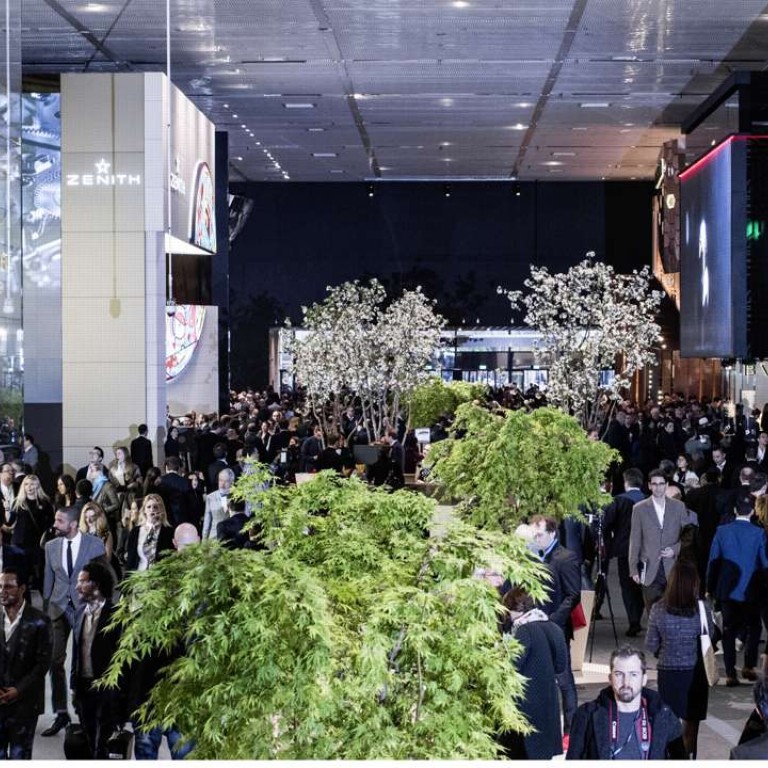
Why Baselworld is no longer as reliable as a Swiss watch
As leading brands such as Tag Heuer and Bulgari offer cheaper pieces amid falling sales, thinner crowds and brand boycotts are undermining the world’s biggest watch and jewellery fair
The world’s premier watch and jewellery trade exhibition traces its roots back to 1917 and this year’s Baselworld expo didn’t miss a beat in playing up its 100-year history. The past week’s show opened to garlanded grandeur, but it belied the uncertainty the Swiss watch world is facing.
According to data from the Federation of the Swiss Watch Industry, Swiss watch sales fell globally in February, down 10 per cent year on year. That included a 12.5 per cent fall in Hong Kong, and a worrying 26 per cent drop in the United States, where many manufacturers had hoped to rebalance their exports away from Asia.

Ritter blamed outside factors, but many manufacturers have balked at the fair’s spiralling booth costs, as well as spending on travel, accommodation and entertainment. For smaller brands, expenses couldn’t be covered.
Rumblings about the cost of exhibiting at Baselworld go back years but have grown louder since global watch sales took a dive in 2014, then sank more the following year. During the 2015 edition of the expo, the Post reported that some exhibitors saw the fair as a drain on resources for launches and region-specific marketing.
In December, Timex Group’s Swiss luxury division – which holds the watch licences for Salvatore Ferragamo, Versus, Versace and Nautica – said it would not be attending this year’s Baselworld. CEO Paolo Marai told Forbes: “Baselworld is a huge investment for everybody, and is, in my opinion, losing some effectiveness.” He said with fewer journalists and retailers turning up in recent years, there was less reason to attend – distributors could be met elsewhere.

This year’s Baselworld did seem smaller and more subdued. “The show was considerably smaller than last year, certainly in terms of exhibitors,” said Vishal Tolani, director of Dartmouth Brands from the UK, which owns and markets the AVI-8 and DuFa brands. “Word was that approximately 200 or so previous exhibitors had either opted to show outside Baselworld or not show at all.”
Tonali echoed Marai’s sentiments that the fair has a problem in convincing people to make the trip to Switzerland. “Visitors from certain markets stayed at home and of those who had to go came well before Baselworld opened for a holiday. A lot of people just don’t want to get on a plane to Europe.”
Inside the exhibition halls, the buzz phrase for many brands was “value” as they looked to adjust their product mix to more economically sober times. LVMH Watch and Jewellery has opted to promote value, with its stable of brands – Tag Heuer, Zenith, Bulgari and Hublot – pushing more steel pieces or cutting prices on premier collections.
Bulgari took a different tack by offering versatility with its new Serpenti – what the brand calls its first customisable watch where the straps can be changed offering a number of different looks. Chopard had the Happy Ocean with a cheaper steel case.

Tag Heuer again made waves with its Connected watch and Frederique Constant, an enthusiastic adopter of the hybrid smartwatch technology, introduced its smart strap that has a small black screen on the strap buckle.
The big names, such as Rolex and Omega, continued to mine their archive for inspiration. Rolex released three versions of the Oyster Perpetual Cosmograph Daytona, now with a ceramic bezel and “Oysterflex” rubber strap. Equally popular, judging by Instagram posts from Baselworld, was Omega’s triple launch of the 1957 Trilogy Limited Editions of the Speedmaster, the Seamaster 300 and the Railmaster. Omega has packaged all three watches in a special anniversary edition box with multiple straps and tools.

